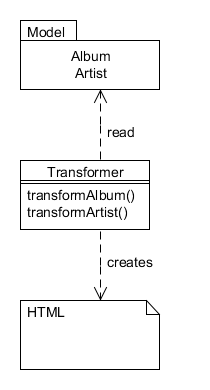Transform view pattern
Fowler argues that this method can be cumbersome for developers because XSLT is a functional language which may be difficult for regular imperative-minded programmers to understand and apply. In this writer's opinion this criticism is becoming less valid every day. Typical programmers are exposed to more and more functional and declarative languages and language features such as LINQ, SQL and the lambda expressions available in a wide variety of modern programming languages.
Another criticism of this pattern is the lack of availability of quality XSLT tools when compared with editors that are compatible with XHTML and therefore play well with Template View.
The main advantage of this pattern is the ability to generate views from platform-agnostic XML. This means the input to the transformer can come from any language or platform as long as it is valid XML. This also leads to more testable code as the transformer output is not dependent on a web server or framework.
